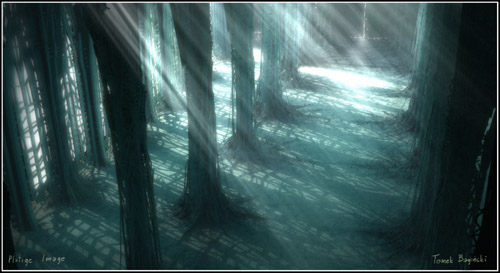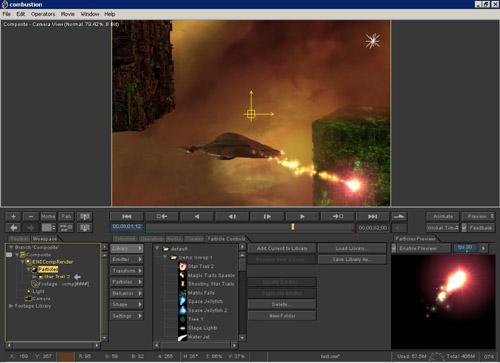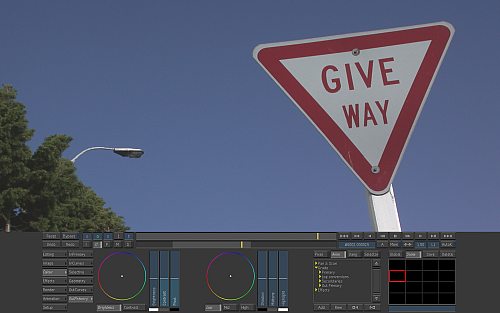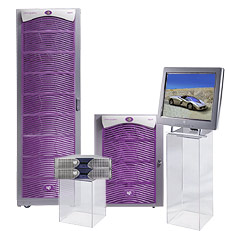With many issues facing discreet, and many questions we have recently wanted answers about, Fxguide sat down for breakfast and 20 questions with the Executive Vice President, Discreet Divison, General Manager Paul Lypaczewski.

Lypaczewski joined Discreet 3 years ago this August, from what he describes as “his mandatory 2 years of web startups” – namely as CEO of CyberWorld Inc ( a 1996 web hosting business startup), and prior to that 6 years at the newly renamed Alias (formerly Alias/Wavefront) as the Vice President of product development. When Alias and Wavefront merged with Silicon Graphics, he became their Senior Director of Research and Development, and then was promoted to General Manager of the Industrial Design Group, responsible for the $40 million business.
FXG: How many people report to you now?
PL: Well we don’t generally openly discuss staffing levels as we are part of a public company,..
FXG: Well the web site says “Currently over 600 employees worldwide”: is that right?
PL: Laughing and noting the point in his palm pilot: Well if it’s on the web site, – it doesn’t sound wrong.
FXG: What % is Discreet of Autodesk’s business?
PL: 18% , at the highest point it was 20% , and I think it has been as low as 17%, but 18%.
FXG: What are the divisions inside Discreet?
PL: Systems products, 3D animation and desktop video.

The Cathedral created on 3DMax
Image courtesy of Platige Image and Tomek Baginski
FXG: How central to Discreet profitability are system products?
PL: It’s huge – the two established business units are systems and 3d, they are profitable and growing, then there is the newer desktop unit which you would not expect to yet be performing, – for a business in its early stage you don’t expect the same profitablity. (editor note: Desktop systems includes Combustion).
It is not secret that the last two years have been brutal for our industry. Brutal. And it is the case that anyone can manage when the business is growing but it is how a company manages the downturns.. so it was with pride that I recently was able to report that Discreet will be returning to profitability this year, an 8% return. This quarter, – the April Quarter is the first profitable quarter in 8.
FXG: Well point blank, with C3 be on G5?
PL: At the moment any announcements will be made at IBC…we will announce our plans then. It is no secret that Adobe, for example, has stopped some development ( ed: of Adobe Premiere). Ut is no secret that the Software community in general has concerns. Apple is a great media creation station, we just launched a new version of Cleaner at the last Macworld. While we are not discussing our exact plans for any product we have to look at 2 questions – one, does it address a customer need and two, can we have a good business?
FXG: So why such a low profile for Combustion at NAB when Apple was so high profile with Shake? Does the entire product have a future?
PL: putting his hand on his heart. Absolutely. We are not killing off the product. NAB is one of 3 main trade shows — NAB, Siggraph and IBC. NAB we just focused on the systems products.

FXG: We also did not see Toxik at this NAB? Is Toxik dead? If not, when will we see it ?
PL: 2 NABs ago, we did have a technical showing of Discreet’s Media Architecture (DMA). We do this to give customers a sense of what your doing and to get feedback. The good news is that we got lots of feedback. We got significant commentary on what we should do and we went off and did it. It’s going well…we have no specific product announcements, but it is still a big part of our plans.
FXG: So who will Toxik be aimed at?
PL: It is a good broad project and our intent is to focus it towards our systems business, but we are not making any specific product announcements.
FXG: What is the single biggest challenge facing Discreet? Because we imagine launching Toxik successfully would be right up there?
PL: Laughing. Well, getting through the last 2 years was a huge challenge. Business has its cycles and this business has its ups and business has its down, we’re happy to say we are now in good shape. But looking forward, more and more of our business is about more than providing creative seats and more about providing creative & productive facilities.
FXG: Lustre… for many years there was a relationship between daVinci and discreet, has that frosted with lustre?
PL: We have a very good relationship with daVinci, what they do melds well with what we do every day.
FXG: How big is the market globally for feature film grading?
PL: The film market is a good growth opportunity. The film market is the leading edge…workflows that start by addressing the needs of the film industry move to other parts of the industry. We see Lustre as no less impactful in its area as flame was when it was released.
FXG: Will you be taking the product down to TVC work?
PL: You need to be able to walk before you can run, in the near term it is the film market. You solve one market before you tackle another.

Lustre Interface
FXG: What is Discreet’s Linux strategy?
PL: In our view, in general, we’re not commited to any operating system, it is what ever is appropriate. We already support and have products on every operating system: Irix for systems, Cleaner on the Mac, Max on Windows, Burn on Linux for example. Linux is just an operating system, no more.
FXG: How is the open framestore stuff coming along?
PL: As planned, it is fundamental to our product planning
FXG: If Discreet is embracing Linux and going open framestore, doesn’t this open the door to illegasl cracks of the Systems products appearing?
PL: We take software theft and piracy very seriously. All of Autodesk does. But it is a bit of a less of concern on say flame, as it is a turnkey system. I used to joke that flame has a dongle – a huge hardware SGI dongle. We need to protect both the software and the investments of our legitimate customers in our products.
FXG: There is an IRIX crack of flame… is that going to be a factor with Linux and open framestores?
PL: It is hard to have a business (ed: flame suite) and keep it hidden commercially. Max and Autocad have a much greater problem. System products in general are still not on systems (PCs) you’d find in the general population, so it not organized crime, it is an issue of casual piracy. Technically speaking we try and stay ahead but that is a ongoing issue. We try and legally work out any issues with customers and our customers are really honest and ethical, if any customer is found to have an issue with say Max, then we give them a chance to address it.
FXG: How do software cracks of Max effect sales and the company?
PL: In some parts of the world it is running 4:1 (ed: cracks vs legal copies), but in the worst parts of the world it is 10:1. In some parts of Asia is … Autodesk takes it extremely seriously.
FXG: Autodesk does what, exactly?
PL: Well interestingly, in countries that have major piracy of software, there is no economic model for a local software industry – their governments get it. Many of those countries work with Autodesk to stop it – at all levels, otherwise they will have no local industry.
FXG: What do you do when you discover a problem?
PL: It depends, we discovered a company selling grey copies of Flame in an Asian country and we warned them, and that is now being solved legally. In another case I was shown through a company who proudly shows us there 130 Max seats, and as we were leaving Peter Moxom (Discreet Asian Max product manager) turned to me and said – except I have only sold them 30. In that case – or a case like that – it is : “you’re busted”. You have a chance to explain and to make the illegal copies legal, should that not work, and it usually does – we would follow it legally. There has been one organized thief group who were attempting to sell flame for a fraction – a fraction of what it costs in various Asian countries, but we stopped that.
FXG: What can we expect at Siggraph?
PL: Siggraph is clearly a show more geared to 3D and Max and we will be making some significant announcements in the 3D part of the Business.

The new SGI hardware systems
As Lypaczewski was the first Canadian to receive the NASA Space Act Award for Exceptional Merit (for his contribution at CAE Electronic Limited, a producer of high technology real time systems), it will be interesting to see if he leads Discreet into a new R&D lead period of expansion with Lustre, Toxik and Linux. Can Discreet can once again match its early flame boom period of growth when Discreet lead the market in innovation? Certainly, many people see Lustre and Toxik as having the potential for industry wide innovation, but daVinci, Apple and others are not as inert as Quantel was during the Henry-Flame wars of the early 90s. In an industry that has suffered slow advertising growth, Sept 11, SARS and global slow downs, only time will tell.
